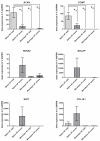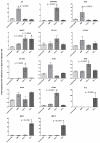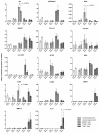Degeneration of Lumbar Intervertebral Discs: Characterization of Anulus Fibrosus Tissue and Cells of Different Degeneration Grades
- PMID: 32245213
- PMCID: PMC7139657
- DOI: 10.3390/ijms21062165
Degeneration of Lumbar Intervertebral Discs: Characterization of Anulus Fibrosus Tissue and Cells of Different Degeneration Grades
Abstract
Intervertebral disc (IVD) herniation and degeneration is a major source of back pain. In order to regenerate a herniated and degenerated disc, closure of the anulus fibrosus (AF) is of crucial importance. For molecular characterization of AF, genome-wide Affymetrix HG-U133plus2.0 microarrays of native AF and cultured cells were investigated. To evaluate if cells derived from degenerated AF are able to initiate gene expression of a regenerative pattern of extracellular matrix (ECM) molecules, cultivated cells were stimulated with bone morphogenetic protein 2 (BMP2), transforming growth factor β1 (TGFβ1) or tumor necrosis factor-α (TNFα) for 24 h. Comparative microarray analysis of native AF tissues showed 788 genes with a significantly different gene expression with 213 genes more highly expressed in mild and 575 genes in severe degenerated AF tissue. Mild degenerated native AF tissues showed a higher gene expression of common cartilage ECM genes, whereas severe degenerated AF tissues expressed genes known from degenerative processes, including matrix metalloproteinases (MMP) and bone associated genes. During monolayer cultivation, only 164 differentially expressed genes were found. The cells dedifferentiated and altered their gene expression profile. RTD-PCR analyses of BMP2- and TGFβ1-stimulated cells from mild and severe degenerated AF tissue after 24 h showed an increased expression of cartilage associated genes. TNFα stimulation increased MMP1, 3, and 13 expression. Cells derived from mild and severe degenerated tissues could be stimulated to a comparable extent. These results give hope that regeneration of mildly but also strongly degenerated disc tissue is possible.
Keywords: anulus fibrosus; degeneration; genome-wide microarray; intervertebral disc.
Conflict of interest statement
J.-P.K. and M.E. are employees of TransTissue Technologies GmbH (TTT). TTT develops regenerative medicine products based on resorbable scaffolds. The authors declare no conflict of interest. The funders had no role in the design of the study; in the collection, analyses, or interpretation of data; in the writing of the manuscript, or in the decision to publish the results.
Figures






Similar articles
-
Cell type-specific effects of Notch signaling activation on intervertebral discs: Implications for intervertebral disc degeneration.J Cell Physiol. 2018 Jul;233(7):5431-5440. doi: 10.1002/jcp.26385. Epub 2018 Jan 19. J Cell Physiol. 2018. PMID: 30025440 Free PMC article.
-
Towards biological anulus repair: TGF-β3, FGF-2 and human serum support matrix formation by human anulus fibrosus cells.Tissue Cell. 2013 Feb;45(1):68-76. doi: 10.1016/j.tice.2012.09.011. Epub 2012 Nov 1. Tissue Cell. 2013. PMID: 23122986
-
Development of a two-step protocol for culture expansion of human annulus fibrosus cells with TGF-β1 and FGF-2.Stem Cell Res Ther. 2016 Jul 12;7(1):89. doi: 10.1186/s13287-016-0332-1. Stem Cell Res Ther. 2016. PMID: 27405858 Free PMC article.
-
Emerging tissue engineering strategies for annulus fibrosus therapy.Acta Biomater. 2023 Sep 1;167:1-15. doi: 10.1016/j.actbio.2023.06.012. Epub 2023 Jun 16. Acta Biomater. 2023. PMID: 37330029 Review.
-
Regeneration in Spinal Disease: Therapeutic Role of Hypoxia-Inducible Factor-1 Alpha in Regeneration of Degenerative Intervertebral Disc.Int J Mol Sci. 2021 May 17;22(10):5281. doi: 10.3390/ijms22105281. Int J Mol Sci. 2021. PMID: 34067899 Free PMC article. Review.
Cited by
-
Identification of core genes in intervertebral disc degeneration using bioinformatics and machine learning algorithms.Front Immunol. 2024 Jul 10;15:1401957. doi: 10.3389/fimmu.2024.1401957. eCollection 2024. Front Immunol. 2024. PMID: 39050860 Free PMC article.
-
Does intradiscal steroid injection accelerate the histological degeneration of the human disc?Osteoporos Sarcopenia. 2024 Sep;10(3):108-113. doi: 10.1016/j.afos.2024.06.001. Epub 2024 Jul 2. Osteoporos Sarcopenia. 2024. PMID: 39403217 Free PMC article.
-
Identification of Core Genes and Screening of Potential Targets in Intervertebral Disc Degeneration Using Integrated Bioinformatics Analysis.Front Genet. 2022 May 30;13:864100. doi: 10.3389/fgene.2022.864100. eCollection 2022. Front Genet. 2022. PMID: 35711934 Free PMC article.
-
Advanced Strategies for the Regeneration of Lumbar Disc Annulus Fibrosus.Int J Mol Sci. 2020 Jul 10;21(14):4889. doi: 10.3390/ijms21144889. Int J Mol Sci. 2020. PMID: 32664453 Free PMC article. Review.
-
Experimental study of miR-503 regulating the activity as well as the function of degenerated human nucleus pulposus cells of the intervertebral disc through inhibiting Wnt pathway.J Musculoskelet Neuronal Interact. 2023 Mar 1;23(1):131-144. J Musculoskelet Neuronal Interact. 2023. PMID: 36856108 Free PMC article.
References
-
- Schmidt C.O., Raspe H., Pfingsten M., Hasenbring M., Basler H.D., Eich W., Kohlmann T. Back pain in the German adult population: Prevalence, severity, and sociodemographic correlates in a multiregional survey. Spine (Phila Pa 1976) 2007;32:2005–2011. doi: 10.1097/BRS.0b013e318133fad8. - DOI - PubMed
-
- Lebow R.L., Adogwa O., Parker S.L., Sharma A., Cheng J., McGirt M.J. Asymptomatic same-site recurrent disc herniation after lumbar discectomy: Results of a prospective longitudinal study with 2-year serial imaging. Spine (Phila Pa 1976) 2011;36:2147–2151. doi: 10.1097/BRS.0b013e3182054595. - DOI - PubMed
MeSH terms
Substances
Supplementary concepts
Grants and funding
LinkOut - more resources
Full Text Sources
Medical
Miscellaneous

